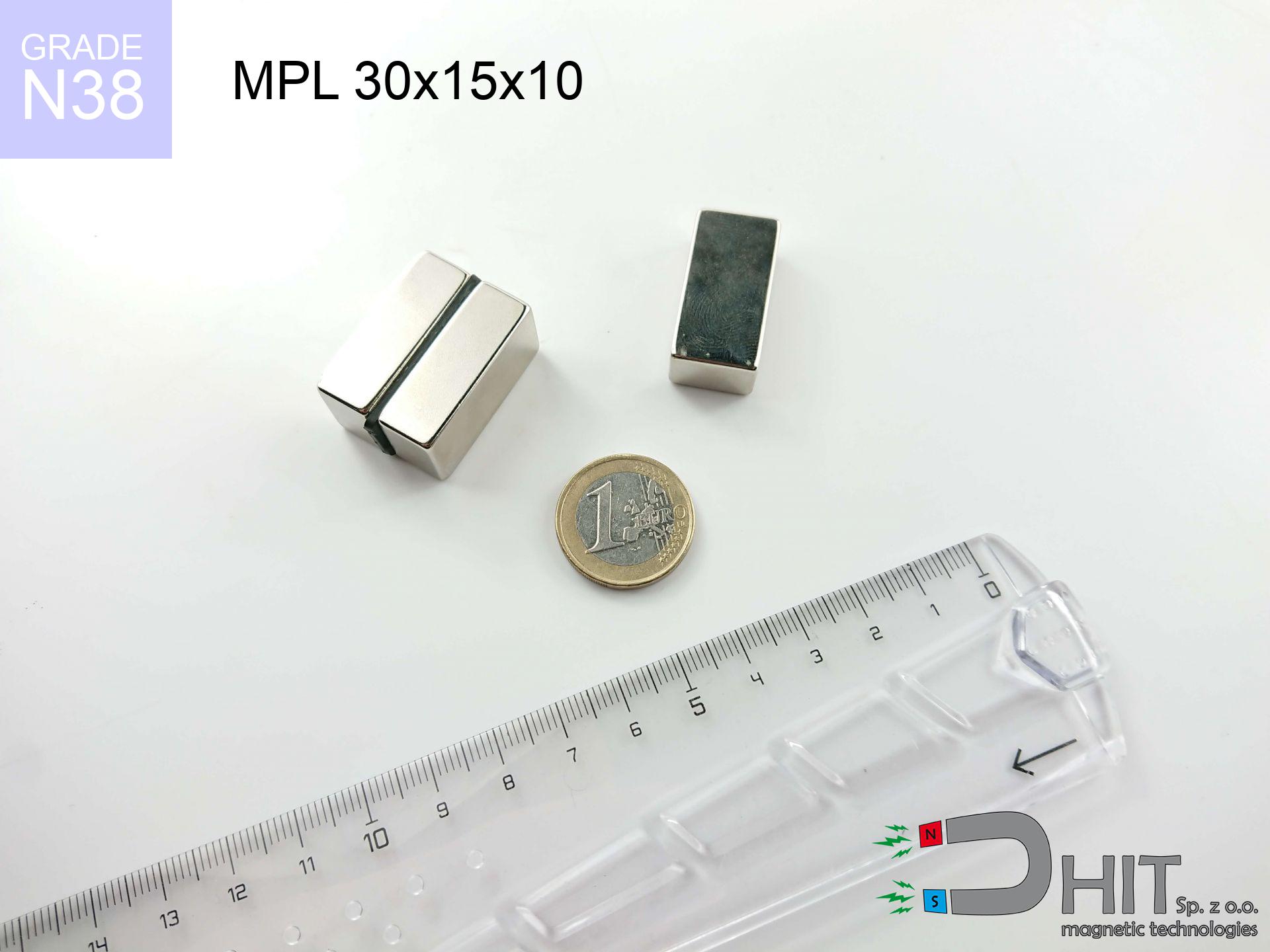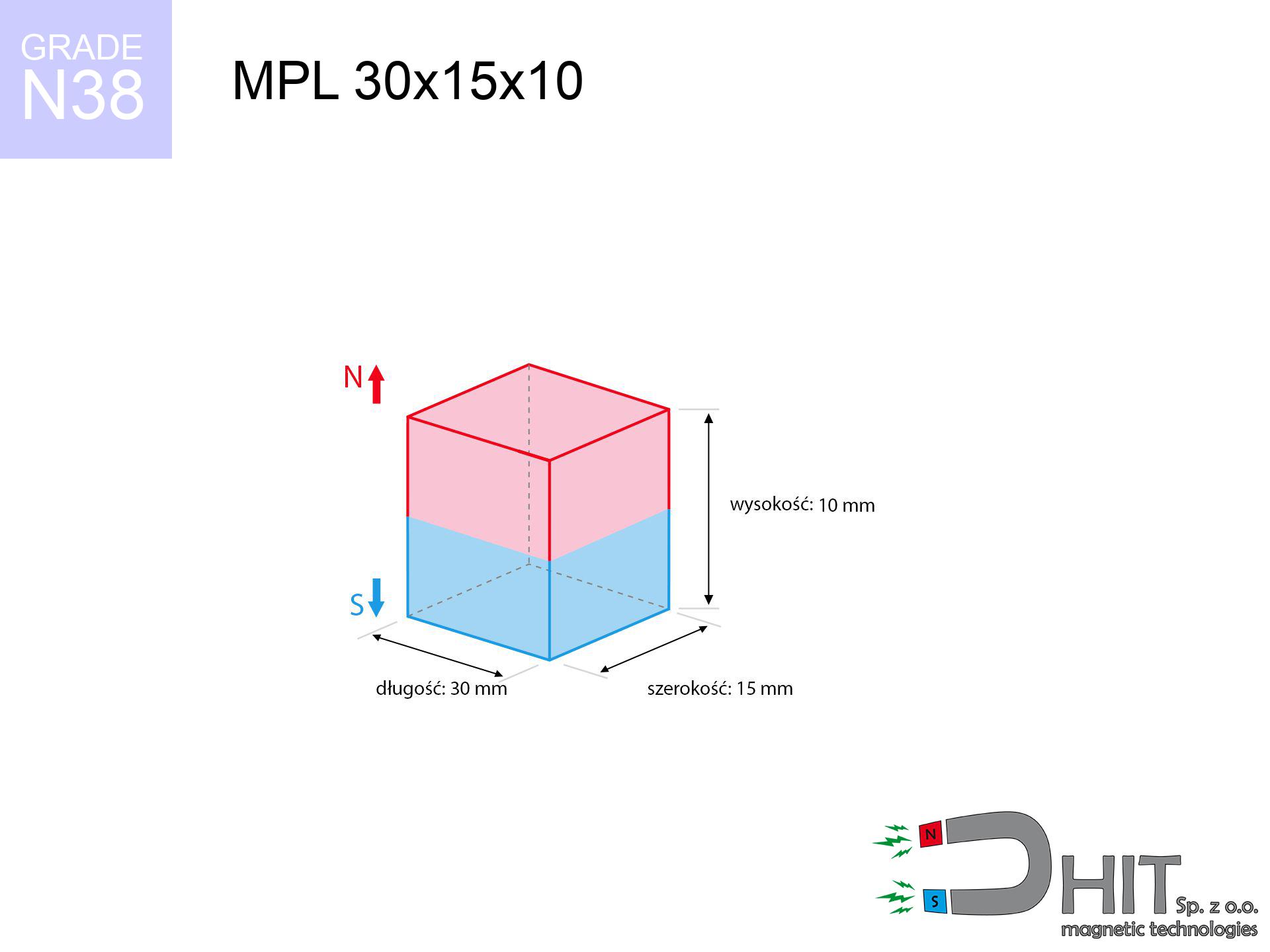MPL 30x15x10 / N38 - lamellar magnet
lamellar magnet
Catalog no 020389
GTIN: 5906301811886
length [±0,1 mm]
30 mm
Width [±0,1 mm]
15 mm
Height [±0,1 mm]
10 mm
Weight
33.75 g
Magnetization Direction
↑ axial
Load capacity
16.75 kg / 164.26 N
Magnetic Induction
413.45 mT
Coating
[NiCuNi] nickel
24.48 ZŁ with VAT / pcs + price for transport
19.90 ZŁ net + 23% VAT / pcs
bulk discounts:
Need more?Hunting for a discount?
Pick up the phone and ask
+48 888 99 98 98
otherwise get in touch via
request form
through our site.
Parameters and shape of a neodymium magnet can be checked using our
online calculation tool.
Order by 14:00 and we’ll ship today!
Magnetic properties of material N38
Physical properties of sintered neodymium magnets Nd2Fe14B at 20°C
Shopping tips
Advantages and disadvantages of rare earth magnets.
In addition to their long-term stability, neodymium magnets provide the following advantages:
- Their strength remains stable, and after around ten years it decreases only by ~1% (theoretically),
- Neodymium magnets are characterized by remarkably resistant to demagnetization caused by magnetic disturbances,
- A magnet with a metallic nickel surface has an effective appearance,
- They are known for high magnetic induction at the operating surface, making them more effective,
- Thanks to resistance to high temperature, they can operate (depending on the shape) even at temperatures up to 230°C and higher...
- Thanks to modularity in shaping and the ability to modify to complex applications,
- Universal use in future technologies – they serve a role in mass storage devices, brushless drives, medical equipment, also industrial machines.
- Relatively small size with high pulling force – neodymium magnets offer high power in compact dimensions, which enables their usage in compact constructions
Problematic aspects of neodymium magnets: weaknesses and usage proposals
- To avoid cracks upon strong impacts, we recommend using special steel holders. Such a solution protects the magnet and simultaneously improves its durability.
- We warn that neodymium magnets can lose their strength at high temperatures. To prevent this, we recommend our specialized [AH] magnets, which work effectively even at 230°C.
- Magnets exposed to a humid environment can corrode. Therefore while using outdoors, we advise using water-impermeable magnets made of rubber, plastic or other material protecting against moisture
- Due to limitations in creating nuts and complicated forms in magnets, we recommend using casing - magnetic mechanism.
- Potential hazard resulting from small fragments of magnets can be dangerous, if swallowed, which gains importance in the context of child health protection. It is also worth noting that small components of these magnets can be problematic in diagnostics medical when they are in the body.
- Higher cost of purchase is a significant factor to consider compared to ceramic magnets, especially in budget applications
Optimal lifting capacity of a neodymium magnet – what affects it?
The specified lifting capacity represents the peak performance, measured under optimal environment, specifically:
- on a block made of mild steel, perfectly concentrating the magnetic field
- possessing a thickness of minimum 10 mm to ensure full flux closure
- characterized by smoothness
- under conditions of no distance (surface-to-surface)
- for force acting at a right angle (in the magnet axis)
- at ambient temperature room level
Key elements affecting lifting force
During everyday use, the actual holding force depends on several key aspects, listed from the most important:
- Space between surfaces – every millimeter of separation (caused e.g. by varnish or dirt) drastically reduces the pulling force, often by half at just 0.5 mm.
- Load vector – highest force is available only during pulling at a 90° angle. The force required to slide of the magnet along the plate is typically several times lower (approx. 1/5 of the lifting capacity).
- Wall thickness – the thinner the sheet, the weaker the hold. Part of the magnetic field penetrates through instead of converting into lifting capacity.
- Chemical composition of the base – low-carbon steel attracts best. Alloy steels decrease magnetic permeability and lifting capacity.
- Smoothness – full contact is obtained only on smooth steel. Rough texture create air cushions, reducing force.
- Heat – neodymium magnets have a sensitivity to temperature. When it is hot they are weaker, and at low temperatures gain strength (up to a certain limit).
* Holding force was checked on a smooth steel plate of 20 mm thickness, when the force acted perpendicularly, in contrast under shearing force the holding force is lower. Additionally, even a slight gap {between} the magnet’s surface and the plate lowers the load capacity.
Precautions when working with NdFeB magnets
No play value
Strictly keep magnets away from children. Choking hazard is high, and the effects of magnets clamping inside the body are very dangerous.
Demagnetization risk
Monitor thermal conditions. Exposing the magnet to high heat will destroy its properties and pulling force.
ICD Warning
Health Alert: Neodymium magnets can turn off heart devices and defibrillators. Do not approach if you have medical devices.
Phone sensors
A powerful magnetic field disrupts the functioning of magnetometers in smartphones and navigation systems. Maintain magnets near a smartphone to prevent breaking the sensors.
Hand protection
Danger of trauma: The pulling power is so immense that it can cause blood blisters, crushing, and broken bones. Use thick gloves.
Shattering risk
Despite metallic appearance, the material is brittle and not impact-resistant. Do not hit, as the magnet may shatter into sharp, dangerous pieces.
Nickel coating and allergies
Medical facts indicate that nickel (the usual finish) is a potent allergen. For allergy sufferers, avoid touching magnets with bare hands or select encased magnets.
Caution required
Handle magnets with awareness. Their huge power can shock even experienced users. Plan your moves and do not underestimate their force.
Combustion hazard
Fire hazard: Neodymium dust is highly flammable. Do not process magnets in home conditions as this risks ignition.
Data carriers
Powerful magnetic fields can corrupt files on credit cards, hard drives, and other magnetic media. Stay away of at least 10 cm.
Danger!
Looking for details? Read our article: Why are neodymium magnets dangerous?




![SM 25x350 [2xM8] / N42 - magnetic separator SM 25x350 [2xM8] / N42 - magnetic separator](https://cdn3.dhit.pl/graphics/products/sm-25x350-2xm8-pim.jpg)
![MPL 40x15x5x2[7/3.5] / N38 - lamellar magnet MPL 40x15x5x2[7/3.5] / N38 - lamellar magnet](https://cdn3.dhit.pl/graphics/products/mpl-40x15x5x27-3.5-cas.jpg)
![UMGGW 22x6 [M4] GW / N38 - magnetic holder rubber internal thread UMGGW 22x6 [M4] GW / N38 - magnetic holder rubber internal thread](https://cdn3.dhit.pl/graphics/products/umg-22x6-m4-gw-jek.jpg)


